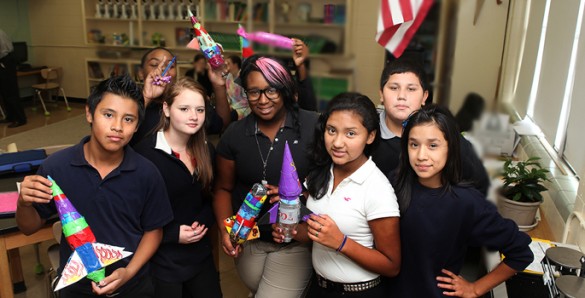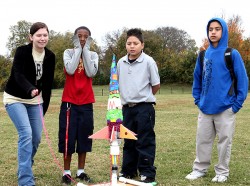
Students from Wright Middle School showing the soda bottle rockets that they have made. (Susan Urmy / Vanderbilt)
Frankie Corradetti stood in front of a class of enthusiastic but wriggly seventh graders. She was flanked on the right by an elaborate stand holding an upside-down soda bottle half filled with water and on the left by a pull down screen showing a picture of the space shuttle on the launch pad at sunset.
“What is the law that explains why our soda bottle rockets can fly?” she asked. “What goes up must come down?” shot back one boy, who was quickly booed down. After a brief pause, another student volunteered, “For every action, there is an equal opposite action.”
“That’s right! It is Newton’s third law of motion: For every action there is an equal and opposite reaction,” she quickly confirmed, clicking on her laptop to bring up a slide titled “3rd Law & Our Rockets” that showed a simple schematic of a soda bottle rocket flanked by a red upward arrow labeled thrust and two downward pointing green arrows labeled weight and air friction.

Frankie Corradetti, left, preparing to launch a soda bottle rocket while its designers look on. (Susan Urmy / Vanderbilt)
Corradetti is a senior majoring in mechanical engineering at Vanderbilt University and a member of Vanderbilt’s Aerospace Club. Her talk was part of an extraordinary five-week educational outreach program that the club has undertaken in collaboration with Peabody College that is introducing seventh grade students at Wright Middle School in Nashville to the field of engineering, many for the very first time.
The club’s primary activity is participating in NASA’s University Student Launch Initiative project, which involves building a high-powered 10-foot rocket, equipping it with an onboard science payload, designing it so it flies as close as possible to one mile in altitude and then parachutes safely back to earth.
The Vanderbilt rocketeers have managed to finish in the money for the last three years competing against more than 40 other university teams. They have been particularly strong in designing innovative payloads. Two years ago, they also decided to go all out on their outreach program, which is evaluated as part of the competition.
“Students in Tennessee public schools aren’t exposed enough to the fun of engineering design,” said Amrutur Anilkumar, the club’s faculty adviser and professor of the practice of mechanical engineering. “So we thought we should introduce the basic engineering design principles early, at the middle school level.”
The engineers approached the experts at Peabody College, the top-ranked graduate education school in the country, with the idea that they could employ simple soda bottle rockets as an entertaining medium for delivering this basic message to middle school students. The science educators at Peabody embraced the idea and an unusual, possibly unique partnership was born.

Heather Johnson organizing the launch competition while Bill Hunnicutt looks on. (Susan Urmy / Vanderbilt)
“I’ve checked around and, as far as I can tell, there is no other project like this here at Peabody,” said Heather Johnson, the assistant professor of the practice of science education who heads up the Peabody side of the effort.
Basically, the engineering students designed various experiments, such as a test stand that holds a bottle rocket in place and measures the force it generates when “fired”, and a test estimating how aerodynamic a paper nose cone is using a hair dryer and a ruler.
At the same time, a group of preservice secondary science teachers at Peabody developed a detailed age-appropriate learning plan. As a result, what had been an afternoon demonstration expanded into a five-week unit in engineering design and soda-bottle rocket design that culminated in a launch competition.
According to Fred Kepner, an education specialist at the NASA Marshall Space Flight Center, the thing that sets Vanderbilt’s outreach program apart is “the long-term engagement they have with the students.” A number of the other teams reach more students “but Vanderbilt’s program is much higher caliber.”
“We’re missing something in education today that the engineers can deliver,” said William Hunnicutt, the middle school science teacher at Wright who turned class over to the Vanderbilt team. “The kids are really taken with it. They strongly resist the didactic, but they’ll remember this. In fact, some of my most difficult kids are the ones who seem to have gotten the most out of it.”
The participation of engineering students like Corradetti was an important part of the program’s success, Hunnicutt and Johnson agreed. In addition to contributing technical information and advice, the university students explained why they were pursuing engineering careers. For example, Corradetti told the class that she wanted to be an astronaut and explore other planets. Currently there is no way to do this. But, instead of giving up on her dream, she decided to study engineering and that gave her the opportunity to work at the Boeing Company last summer on NASA’s Space Launch System which is being designed to allow a resumption in space exploration.
“The engineering students helped the middle schoolers connect to a possible career choice that was unfamiliar to most of them,” Johnson reported. At every opportunity, the seventh graders peppered the engineering students with questions about what they would do after they graduated, how much money they would make and dozens of similar topics.
“The engineering students brought an energy to the classroom that was a great help to my students,” said Hunnicut, “because it helped them find or improve upon their personal sense of the importance of their school work.”
As part of the program, the students were tested before and after the unit to measure what they had learned. “The testing showed that students could talk about the engineering design process in greater detail and with more sophistication after the program,” Johnson summarized. “There was growth in all sections of the assessment but the most striking change is that students’ knowledge of Newton’s third law of motion greatly improved, although their application of the law was still not great.”
The Aerospace Club intends to incorporate the lessons they’ve learned and repeat the program next year. In addition, two of the preservice education majors who were involved in the program last year are now working as science teachers in other middle Tennessee schools and the engineers intend to “re-engage” them by offering to provide them with the basic tools they need so they can conduct the lessons themselves.
The engineering bug even appears to have bitten Hunnicutt: “Before this I didn’t have any engineering background. But they have also trained me. At some point I’ll be able to teach this material myself.”
Although the day of the final launch competition was chilly and grey, the air was festive as the students trooped outside proudly carrying their brightly decorated bottle rockets. Sixty odd students milled around the two launch stands that the engineering students had set up in the athletic field. The bottle rockets were launched in pairs and their performance measured by how high they flew and how close they landed to the launch site.
When one of the rockets flew straight and high, there were plenty of clapping and ooohs and aaahs from the crowd. When one veered off and shot across the field, there were boos and a lot of laughter.

Winners of the competition posing with Bill Hunnicutt, left, Frankie Corradetti, Collin Grimes, Brock Smethills, Ryan Thompson, Jason Lee and Heather Johnson,
At the end of the competition, the winning teams were announced and their pictures were taken with the Vandy engineers. Their prize is a field trip to Vanderbilt for a tour of the Aerospace Club lab in the spring.
Photo credits: Susan Urmy





